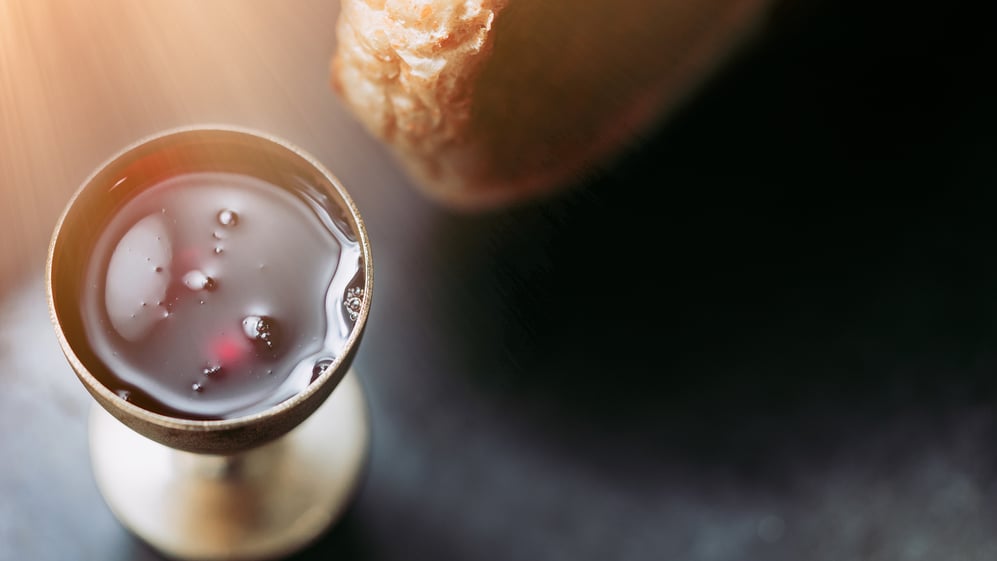We continue our series on teaching Luther’s Small Catechism to students. In this blog, we explore the First and Second Sections of the Lord’s Supper.
The Lord’s Supper, First Section:
What is the Sacrament of the Altar? It is the true body and blood of our Lord Jesus Christ under the bread and wine, instituted by Christ Himself for us Christians to eat and drink.
Where is this written? The holy Evangelists Matthew, Mark, Luke, and St. Paul write: Our Lord Jesus Christ, on the night when He was betrayed, took bread, and when He had given thanks, He broke it and gave it to the disciples and said: “Take, eat; this is My body which is given for you. This do in remembrance of Me.”
In the same way He also took the cup after supper, and when He had given thanks, He gave it to them, saying, “Drink of it, all of you; this is the cup of the new testament in My blood, which is shed for you for the forgiveness of sins. This do, as often as you drink it, in remembrance of Me.”
A little boy declares to his father, “I don’t want to go to school today.”
“You have to go to school,” asserts his father.
“Why?” replies the boy.
“Because I said so.”
There ends the discussion. There are times when dealing with children that reasoning is fruitless. “I said so” is the only appropriate response. The father is making what is called an argument from authority. The boy must do what his father says simply because his father is his father and is in charge. Similarly, we take Jesus’ words regarding the Lord’s Supper on authority. Jesus is God. He says that this bread and wine are His body and blood, and we take His word for it. In teaching the real presence to children, you may find they are quite open to Jesus’ argument from authority. It’s when we reach our adolescent years that a sinful skepticism sets in.
An excellent way to present the Lutheran view on the Lord’s Supper is to compare it to others. There are three prevalent views on this Sacrament. The first is transubstantiation. This is a long word which means that the substance, the essence, of the bread and wine has changed. Those holding this view assert that with Christ’s words, the bread and wine cease to be bread and wine and become Christ’s body and blood permanently. The second view holds that the Lord’s Supper does not bring true body and blood, but it is rather a mere symbol or remembrance of Christ’s event with the disciples. The Lutheran, or biblical, view asserts that Christ is truly, or sacramentally, present in, with, and under the bread and wine. Those receiving the Lord’s Supper take bread, wine, body, and blood. This view holds firmly to Christ’s word “is” (e.g., Matthew 26:26, 28). This is an argument from authority.
The Lord’s Supper, Second Section:
What is the benefit of this eating and drinking? These words, “Given and shed for you for the forgiveness of sins,” show us that in the Sacrament forgiveness of sins, life, and salvation are given us through these words. For where there is forgiveness of sins, there is also life and salvation.
When teaching the Lord’s Supper, place great emphasis on the almighty power of God’s Word. As explained above, Christ is truly present because our Lord says so. His Word brings His body and blood to the bread and wine, making it a Sacrament. While the pastor speaks the Word over the bread and wine, the power resides in the Word, not in the man. This becomes important when we think about faith as it relates to the Lord’s Supper. There are some who hold the opinion that in the Lord’s Supper the bread and wine bring the body and blood of Jesus only to those who believe so. Ultimately, this false notion is based on a sinful lack of awe regarding the power of God’s Word and an overestimation of the capacity of one’s faith to make change. To those who hold this error, Lutherans politely respond that God’s Word trumps all.
Given that God’s Word trumps all, we can trust what the Lord says regarding its benefits. Jesus asserts that His body and blood are “given and shed for the forgiveness of sins.” In this we can be confident that in taking the body and blood of Jesus Christ our sins are indeed forgiven, not because we are good people or as a reward for doing good things, but simply because Jesus says so.
Jesus also comforts those receiving the Lord’s Supper in faith that their sins are truly forgiven. And with the forgiveness of sins, the certainty that life and salvation will surely follow. Take students back to the Garden of Eden. God created Adam and Eve without sin. They were perfectly righteous. In this righteousness they naturally also had eternal life. They needed no salvation because they had no sin. When God forgives our sins for the sake of Jesus’ death on the cross and His resurrection, in this case through the Sacrament of the Lord’s Supper, eternal life and salvation follow as a result.
When distributing the Lord’s Supper to the members of my congregation, I often make statements such as, “the resurrected body of your Lord and Savior Jesus Christ, given for you on the cross for the forgiveness of your sins,” or “the true blood of Jesus Christ, shed on the cross for you for the forgiveness of your sins.” I assert “the resurrected” body and “shed” on the cross to help those receiving make the connection between what Christ did at the cross and empty tomb and what they are receiving. They receive Christ, our Savior’s body and blood, for the forgiveness of sins and the resulting life and salvation.
Small Catechism quotations are from Luther’s Small Catechism with Explanation © 1986 Concordia Publishing House. All rights reserved.
Scripture: ESV®.
Continue your exploration of the Lord’s Supper in Luther’s catechisms.














